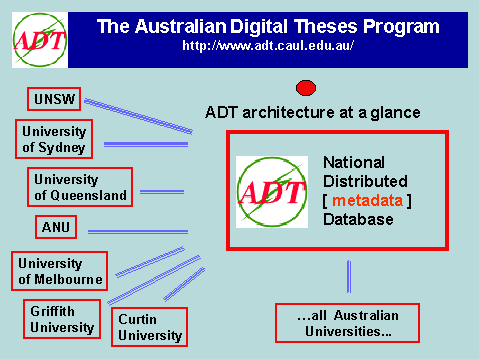 |
Australian
Digital Theses Program
|
| Aims & Overview |
|
Aims The aim of the ADT program is to establish a distributed database of digital versions of theses produced by the postgraduate research students at Australian universities. The theses will be available worldwide via the web. The ideal behind the program is to provide access to, and promote Australian research to the international community. The initial project was funded by an Australian Research Council (ARC) - Research Infrastructure Equipment and Facilities (RIEF) Scheme grant (1997/1998).The ADT concept was an initiative of 7 Australian universities (listed below) in association with the Council of Australian University Librarians ( CAUL ). The ADT model was developed by the 7 original project partners during 1998-1999. The program was then opened up to all CAUL members (all Australian universities) in July 2000. The original 7 patners will continue to guide and advise the national group in their role as the ADT Steering Committee. The original ADT membership group:
ADT Program Overview The ADT program is designed to improve
access to, and enhance transfer of, the research information contained
in theses by providing a full text version available from the desktop
via the web. The retrieval is enhanced by the inclusion of metadata
tags in the documents which are given a higher weighting by the more
sophisticated search engines. The program has two major components, digitisation of theses as part of the deposit process and the digitisation of a selected number of frequently requested existing theses. As each University is responsible for maintaining an archival copy of the theses of their own institution, each participant in the program will mount their own theses on a server located in their respective institution. The participants will use the same database configuration, standards and metadata system to ensure compatibility. The document format will be Adobe Acrobat Portable Document Format (PDF) ensuring that the data is independent of the platform on which it is created. Adobe PDF ensures that a high quality printed version can be provided if needed. Acrobat is relatively easy to use, with a high quality free reader readily available. PDF has also become an electronic publishing standard.
|
© UNSW Library 1997 - Updated
23/02/00 - Web
Co-ordinator
Please read this disclaimer
